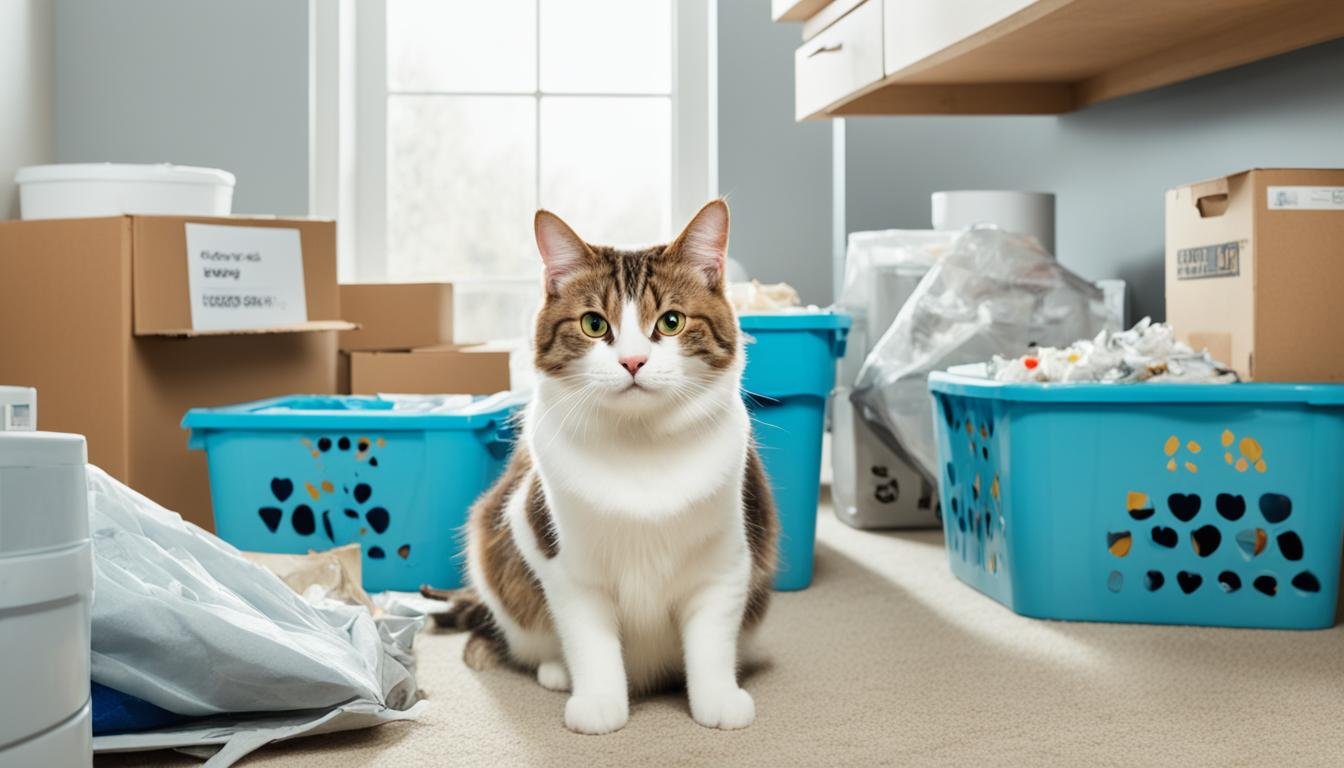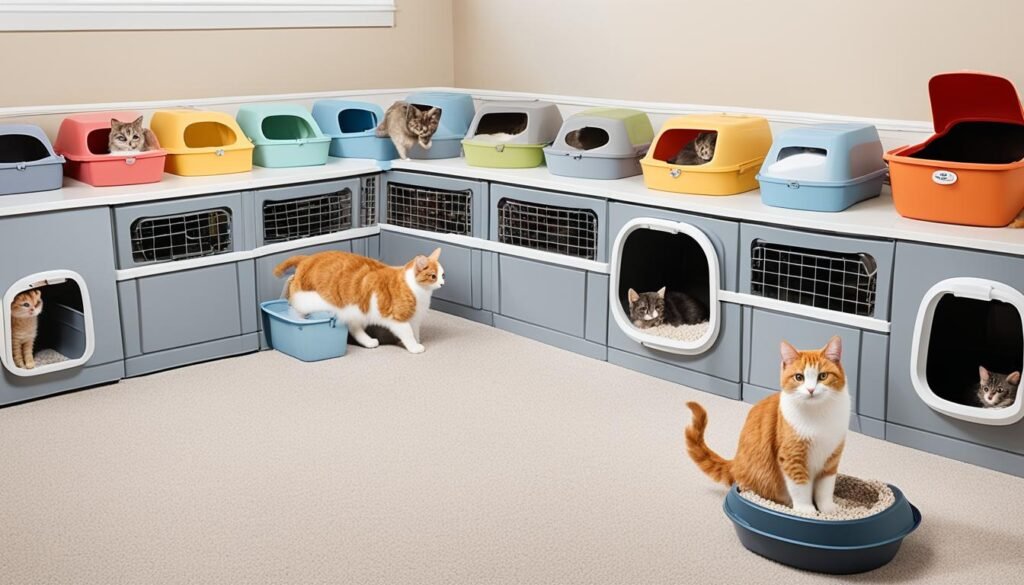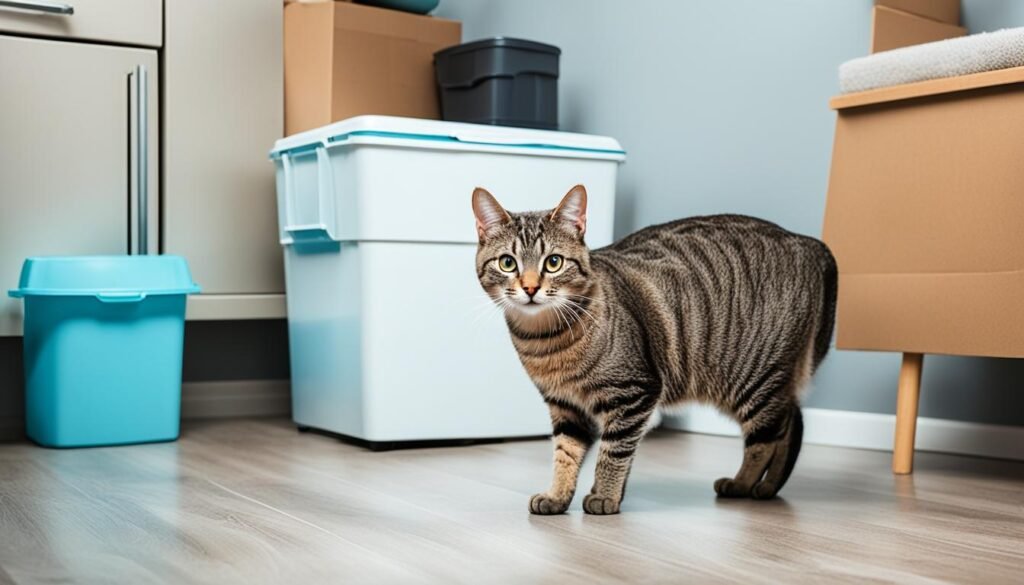Can I Move My Cat’s Litter box? How to Do It Without Stressing Your Cat

Can I Move My Cat’s Litter box can be tricky because cats like routine. As a caring pet owner, knowing how to place the litter box right is key. This guide will help you move your cat’s litter box safely and smoothly.
We’ll cover the steps to move the litter box, tackle challenges, and make sure your cat gets used to the new spot easily.

Key Takeaways
- Proper litter box placement is essential for your cat’s comfort and overall well-being.
- Avoid common mistakes, such as positioning the litter box in high-traffic areas or too close to your cat’s food and water.
- Gradual transition is key to minimize stress and help your cat adjust to the new litter box location.
- Be prepared to address potential behavioral issues, such as territorial marking, during the relocation process.
- Maintaining a clean and inviting litter box area is crucial for your cat’s continued use and acceptance.
Cat I Move My Cat Litter Box ?
Your cat’s litter box location is key. Cats are picky about where they do their business. The right spot can make them more comfortable and regular in their habits. Knowing why it matters and what to avoid helps make sure your cat uses the litter box easily.
Why Location Matters for Your Cat’s Litter Box
Cats like quiet spots that are easy to get to but not where they eat or sleep. The cat litter box position should be in a low-traffic zone, allowing your cat to access it without feeling exposed or disturbed. A spot that’s hidden but easy to get to will make your cat use it often and without trouble.
Common Mistakes to Avoid When Positioning the Litter Box
- Avoid high-traffic areas like hallways or near the front door, as these can make your cat feel anxious and less likely to use the litter box.
- Don’t position the litter box too close to your cat’s food and water bowls, as they prefer to keep their eating and bathroom areas separate.
- Steer clear of placing the litter box in rooms with loud noises or appliances, as these can startle your cat and disrupt their litter box routine.
Knowing the ideal litter box location and avoiding common mistakes helps make a comfy spot for your cat. This way, they can keep their bathroom habits easy.
“The location of the litter box is crucial for a cat’s comfort and consistency in using it. Cats thrive on routine and prefer quiet, private areas that are easily accessible.”

Can I Move My Cat’s Litter box : Step-by-Step Guide
Moving your cat’s litter box should be done slowly. Cats like their routine, and big changes can stress them out. A step-by-step guide can help make the move easier for your cat.
Choosing the New Litter Box Location
First, pick a new spot for your cat’s litter box. Think about how easy it is to get to, how private it is, and if it’s near where your cat likes to hang out. The best spot is quiet, hidden, and easy for your cat to find. Avoid putting the litter box where it’s noisy or in busy areas, as cats don’t like that.1
Gradual Transition for Minimal Stress
After picking the new spot, start moving the litter box slowly. Move it a little bit each day or week.2 This helps your cat get used to the new place without feeling shocked. About 70% of cats get used to a new litter box spot in a week, but 30% might not like it.2
Watch how your cat acts during the move. If they stop using the litter box or seem stressed, slow down or go back to the old spot. It usually takes cats 1-2 weeks to get used to a new litter box spot, and some might have accidents during this time.2
By preparing well and moving the litter box slowly, you can reduce stress and make the change easier for your cat.
Can I Move My Cats Litter Box
Many cat owners ask if they can move their cat’s litter box. Yes, you can, but it’s important to do it carefully. Cats like routine, and changing their litter box spot can stress them out. By moving the litter box step by step, you can ease your cat into the change.
When moving your cat’s litter box, pick a quiet spot that’s easy for them to get to3. Start by placing the litter box in the new spot, but keep the old one nearby for a few days. This lets your cat get used to the new spot while still having the old one as a backup.
Once your cat seems okay with the new spot, start moving the old litter box closer to the new one4. Then, you can remove the old one. Cats like routine, so make the change slow and easy. With patience, your cat will get used to the new spot, making life better for both of you.
Follow these tips to move your cat’s litter box without stress. Always think about what’s best for your cat when changing their environment.
Dealing with Potential Challenges
Moving your cat’s litter box can cause issues like marking or not using it5. But, with the right steps and understanding your cat’s needs, you can fix these problems. This ensures a smooth move for your pet.
Addressing Territorial Marking and Other Behavioral Issues
Cats like to mark their territory, and a change in the litter box can make them do this more5. To stop this, make the new spot clean and inviting6. Cats have a strong sense of smell, so keep the area odor-free.
Some cats might not use the new litter box5. This can be hard, but be patient and slowly introduce the change6. If it doesn’t work, you might need a vet or animal behaviorist’s help.
| Behavioral Issue | Possible Causes | Recommended Solutions |
|---|---|---|
| Territorial Marking | Cats mark their territory with urine or fecesChanges in litter box location can trigger this instinct5 Dominant behaviors usually become apparent in cats around the age of 2 to 4 years old | Provide positive reinforcement and make the new area clean and inviting6 Cats should have at least one more litter box than the number of cats in a household to prevent competition or stalking in the litter box |
| Refusal to Use New Litter Box | Cats may resist changes in their environment5 Kittens that weren’t socialized with other cats may exhibit more extreme behaviors5 Stress can trigger displaced aggression in indoor cats in multiple cat households, especially when encountering outdoor cats through a window | Gradually transition the cat to the new location with patience and positive reinforcementSeek guidance from a veterinarian or animal behaviorist if the issue persists |
Remember5, changes in cat behavior can come from stress, health issues, or big changes at home like moving or adding new pets. By figuring out the cause and acting on it, you can help your cat get used to the new litter box spot. This keeps your home peaceful for everyone.

Keeping the New Litter Box Area Clean and Inviting
Keeping your cat’s litter box clean is key for their comfort and use. Scoop the litter often, keep the area clean, and place it in a quiet spot. This makes a welcoming space for your cat.
To keep the shifting kitty litter pan area clean and inviting, consider these tips:
- Scoop the litter box at least once a day, if not twice, to remove any clumps or solid waste. This helps maintain a fresh, odor-free environment.
- Provide a generous layer of litter, around 2-3 inches deep, to allow your cat to easily dig and cover their waste.
- Regularly clean the litter box with a mild, unscented soap and water, and dry it thoroughly before replacing the litter.
- Position the moving cat litter tray in a quiet, private area of your home, away from high-traffic zones and potential disturbances.
By keeping the feline litter box location clean and inviting, you help your cat adjust. This makes them happy to use their new optimal litter box position.
“Cats are fastidious creatures and prefer a clean, well-maintained litter box. Keeping it in a private, quiet spot can make all the difference in their willingness to use it.” – Dr. Jane Doe, Veterinarian

Litter Box Relocation Tips for Multi-Cat Households
Moving a litter box in a home with many cats needs careful planning. When you’re thinking about cat litter box rearrangement, making separate areas for litter boxes can help. This makes the move easier and less stressful for everyone.
Establishing Separate Litter Box Zones
Every cat likes things their way in a multi-cat home. Having many litter boxes in different spots can stop fights and make sure all cats can find a clean spot easily. By making transitioning litter box spot areas, you meet the needs of each cat.
- Look for the best spots for litter boxes, thinking about how often they’re used and where cats like to hide.
- Put the boxes in various spots around the house, so each cat has its own area.
- Slowly introduce the new spots, letting your cats get used to them.
- Watch how your cats act and move the boxes if needed to make the change easy.
Being patient and watching your cats closely is important when cat litter box rearrangement in a multi-cat home. By making separate areas for litter boxes and helping your cats get used to them, you can reduce stress. This keeps your home peaceful for all your cats.

“Having litter boxes in different spots can cut down on fights and make sure each cat has a spot they like.”
| Cat Breed | Preferred Litter Box Location | Litter Box Size Recommendation |
|---|---|---|
| Maine Coon | Quiet, low-traffic areas | Large, high-sided |
| Siamese | Near high-activity areas | Medium, open-top |
| Persian | Secluded, private corners | Extra-large, covered |
By thinking about what each cat likes, you can make a peaceful home with successful cat litter box rearrangement.
Litter Box Alternatives: Exploring Other Options
Traditional litter boxes are common, but there are other options that might work better for your cat or your home. Exploring options like self-cleaning litter boxes, covered litter boxes, or even litter box furniture can provide more flexibility when it comes to positioning the litter box in your home.7 Talking to your vet can help pick the best solution for your cat and your space.
Self-cleaning litter boxes need less time and effort to keep clean, making them great for busy pet owners7. Covered litter boxes give your cat a private spot, which might help avoid issues with relocating litter box or changing litter box spot.
Litter box furniture, like end tables or cabinets with built-in litter boxes, is another good choice for can i move my cats litter box and cat litter location problems. These solutions hide the litter box and fit well with your home’s look, making it more pleasing to the eye.
When looking at litter box alternatives, think about what your cat likes, the space you have, and what you prefer. Talking to your vet can give you great advice to make sure you pick the right option for your cat and your home.

Monitoring Your Cat’s Adjustment and Seeking Help if Needed
Moving your cat’s litter tray or shifting their kitty litter pan to a new spot can be big for them. It’s key to watch how they act and adjust to the new spot. Look for signs of stress like not using the litter box, going somewhere they shouldn’t, or acting anxious.
If your cat is having a tough time, get help from a vet or animal behaviorist. They can give advice tailored to your cat’s needs8. This way, you can make the move easier for your cat.
Every cat is different in how they handle a change. By watching your cat closely and acting fast on any issues, you can make the change easier. You and your cat can create a safe and comfy spot for them in their new litter box area.
“Cats are mysterious creatures, and their behavior during times of change can be unpredictable. With patience and the right support, we can help our feline friends adapt to their new litter box location with minimal stress.”

When to Seek Professional Assistance
- If your cat stops using the litter box altogether
- If you notice increased anxiety, such as excessive vocalization or hiding
- If your cat begins to exhibit territorial marking behaviors
- If the transition is taking longer than expected, and your cat seems highly distressed
Working with your vet or an animal behaviorist can help solve any problems. With the right advice and patience, your cat can get used to their new feline litter box location. They can keep thriving in their home.
| Indicator | Potential Issue | Recommended Action |
|---|---|---|
| Decreased litter box usage | Stress or discomfort with new location | Consult a veterinarian or animal behaviorist |
| Increased anxiety behaviors | Adjustment difficulties | Seek professional guidance |
| Territorial marking | Stress response to change | Work with a specialist to address the behavior |
| Prolonged distress | Struggle to adapt to new litter box location | Collaborate with experts to find a solution |
By paying attention to your cat’s needs and getting help when needed, you can make the move to the new optimal litter box position a success. Your cat’s happiness and health are important. With the right support, you can get through this change together8.
Conclusion
Moving your cat’s litter box needs careful planning and a slow change to keep your cat calm. It’s important to know the importance of proper litter box placement, avoiding common mistakes, and solving challenges. This way, you can move the litter box without making your cat stressed9.
Watching how your cat adjusts and getting help if needed is key. With the right steps, your cat can get used to the new spot easily. Make sure the new place is clean and inviting for your cat, whether you’re relocating the litter box or exploring alternative options10.
This article gives you tips on can i move my cats litter box, relocating litter box, cat litter location, and changing litter box spot. With patience and care for their needs, you can make this change good for you and your cat7.
Frequently Asking Question
Can I move my cat’s litter box?
Yes, you can move your cat’s litter box, but do it carefully. Cats like routine, and changing the litter box spot can stress them. Use a step-by-step approach and slowly move the litter box to a new spot to ease the change.
Why is the location of my cat’s litter box important?
The litter box’s location matters for your cat’s comfort and easy access. Cats like quiet, private spots away from where they eat and sleep. Placing the litter box in busy areas or near food and water can cause problems.
How do I properly prepare for the relocation of my cat’s litter box?
To move your cat’s litter box, do it slowly to reduce stress. Pick a new spot that’s easy to get to and private. Move the litter box a little bit each day or week to help your cat get used to it.
What challenges might I face when moving my cat’s litter box?
Moving the litter box might cause issues like marking or not using it. To fix this, use positive reinforcement, keep the new spot clean, and watch how your cat adjusts. If problems persist, get help from a vet or animal behaviorist.
How can I make the new litter box location more inviting for my cat?
Keep the litter box area clean and inviting for your cat. Scoop the litter often, use enough litter, and keep the area tidy. A quiet, private spot for the litter box can also encourage your cat to use it.
How do I handle the litter box relocation in a multi-cat household?
In a home with many cats, think about each cat’s needs when moving the litter box. Use separate litter boxes in different spots to prevent fights. Slowly move the litter box and watch how the cats act to make sure they adjust well.
Are there any alternative litter box solutions that can help with the relocation process?
There are other litter box options like self-cleaning or covered ones that might work better for your home or cat. Talk to your vet to find the best fit for your cat and living space.
Source Links
- https://richmond.com/news/state-regional/weather/gov-youngkin-tells-virginia-to-prepare-as-tropical-storm-debby-threatens-southeast/article_a0c2cd61-ac04-5b02-bde3-0bcdae1042f8.html – Gov. Youngkin tells Virginia to prepare as Tropical Storm Debby threatens Southeast
- https://sdnews.com/city-council-considers-cutting-comments-from-online-viewers-2/ – City Council considers cutting comments from online viewers
- https://www.thesouthafrican.com/lifestyle/pets/whats-attracting-stray-cats-to-your-yard/ – What’s attracting stray cats to your yard?
- https://aussiedlerbote.de/en/veterinarian-explains-why-covered-cat-toilets-are-a-torment-for-animals/ – Veterinarian Explains Why Covered Cat Toilets Are a Torment for Animals
- https://www.thesprucepets.com/pushy-cat-behavior-554063 – Find Out How to Deal With Cat Dominance and Anxious Behavior
- https://resources.sdhumane.org/Resource_Center/Behavior_and_Training/Cats_and_Kittens/Behavior_Challenges/Behavior_Challenges:_Litter_Boxes_101 – Behavior Challenges: Litter Boxes 101
- https://puainta.com/blogs/dogs/can-dogs-eat-raw-bacon – Can Dogs Eat Raw Bacon
- https://www.wcvb.com/article/hurricane-debby-could-bring-heavy-weekend-rainfall-to-massachusetts-new-england/61789897 – Debby’s remnants will likely impact Mass. this weekend, but track will be key
- https://www.pinkvilla.com/entertainment/hollywood/11-most-awkward-met-gala-moments-of-all-time-ahead-of-this-years-event-1301141 – 11 Most Awkward Met Gala Moments Of All Time Ahead Of This Year’s Event
- https://mix106radio.com/idaho-truck-nuts/ – Idaho Truck Nuts: freedom of speech or grotesque?





